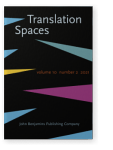Maze-walkers and echoborgs
Reflections on translator metaphors
The article fills a gap in the existing array of translation metaphors by introducing maze-walkers as a metaphor
for translators at work. Ten similarities and five dissimilarities between translating and walking through a hedge maze are
discussed. Translators’ control over their actions is compared to that of maze-walkers and of four other metaphorical agents:
stage and musical performers, puppeteers, echoborgs and ghost-writers. Most existing metaphors convey attitudes toward
translations and translators, whereas the maze-walking metaphor captures the varied actions of a translating translator. The
metaphor may be of value to anyone explaining translation to students.
Article outline
- 1.Types and functions of metaphors
- 2.Types of maze
- 3.How are maze-walkers like translating translators?
- 4.How does maze-walking differ from translating?
- 5.Four voice control metaphors
- 6.Metaphors versus subclasses
- 7.Product, process or agent?
- 8.The subjective experience of maze-walking
- 9.Further work
- 10.Concluding remarks
- Notes
-
References
References (24)
Baudrillard, Jean
[1981]
1994 Simulacra and Simulation. Translated by
Sheila Glaser. Ann Arbor: University of Michigan Press.

Benshalom, Yotam
2010 “
Performing
Translation.” In
Thinking Through Translation with
Metaphors, edited by
James St. André, 47–74. Manchester: St. Jerome.

Borges, Jorge
[1941]
1962 “
The Garden of Forking Paths.” Translated
by
Anthony Boucher. In
Ficciones. New York: Grove.

Boyd, Richard
1979 “
Metaphor
and Theory Change: What is ‘Metaphor’ a Metaphor for?” In
Metaphor
and Thought, edited by
Andrew Ortony, 356–408. Cambridge: Cambridge University Press.

Chesterman, Andrew
2009 “
The
Name and Nature of Translator Studies.”
Hermes: Journal of Language and Communication
Studies 421, 13–22.

Corti, Kevin and Alex Gillespie
2015 “
A
Truly Human Interface: Interacting Face-to-face with Someone Whose Words are Determined by a Computer
Program.”
Frontiers in
Psychology 61, 1–18.


Dastyar, Vorya
2017 Dictionary
of Metaphors in Translation and Interpreting
Studies. Tehran: Rahnama Press.

Fisher, Adrian and George Gerster
[1990]
2000 The Art of the
Maze. London: Seven Dials.

Lakoff, George and Mark Johnson
1980 Metaphors
We Live By. Chicago: University of Chicago Press.

Levý, Jiři
1967 “
Translation
as a Decision Process.” In
To Honor Roman
Jakobson Vol. 21. The Hague/Paris: DeGruyter Mouton, 1171–1182.

Martín de León, Celia and Maria Presas
2011 “
Metaphern als Ausdruck
subjektiver Theorien zum Übersetzen [metaphors as expressions of subjective theories of
translation].”
Target 23 (2), 272–310.

Mossop, Brian
2010 “
Translating
what might have been written”. In
Text and Context: Essays on
Translation and Interpreting in Honour of Ian Mason, edited by
Mona Baker,
Maeve Olohan and
María Calzada Pérez, 95–113. Manchester: St. Jerome.

Phillips, Anthony
1992 “
The
Topology of Roman Mosaic
Mazes.”
Leonardo 25 (3/4), 321–29.


Reed Doob, Penelope
1990 The
idea of the labyrinth from classical antiquity through the Middle
Ages. Ithaca: Cornell University Press.

Schleiermacher, Friedrich
[1813]
2012 “
On the Different Methods of
Translating.” In
The Translation Studies
Reader 3rd ed., edited by
Lawrence Venuti, 43–62. Translated
by
Susan Bernofsky. London: Routledge.

St. André, James
2010a “
Translation
and Metaphor: Setting the Terms.” In
Thinking Through Translation
with Metaphors, edited by
James St. André, 1–16. Manchester: St. Jerome.

St. André, James
2010b “
Translation
as Cross-identity Performance.” In
Thinking Through Translation with
Metaphors, edited by
James St. André, 275–294. Manchester: St. Jerome.

St. André, James
2019 “
List
of Metaphors for Translation.”
[URL]
Taivalkoski-Shilov, Kristiina
2010 “
When
Two Become One: Reported Discourse Viewed through a Translatological
Perspective.” In
Translation effects. Leuven: CETRA, edited by
Omid Azadibougar, 16 pp.
[URL]
Taivalkoski-Shilov, Kristiina
2013 “
Voice
in the field of translation studies.” In
La traduction des voix
intra-textuelles / Intratextual voices in translation, edited by
Kristiina Taivalkoski-Shilov and
Myriam Suchet, 1–10. Montréal: Éditions québécoises de l’oeuvre.

Tatarella, Francesca
2016 Labyrinths
& Mazes: a journey through art, architecture, and landscape. New York: Princeton Architectural Press.

Turchi, Peter
2014 A
Muse and a Maze: writing as puzzle, mystery, and magic. San Antonio, Texas: Trinity University Press.

Ullyatt, Tony
2010 “
‘An
Abstract Model of Conjecturality’: Prolegomenon to an Understanding of Labyrinths and Mazes as
Metaphors.”
Journal of Literary
Studies 26 (4), 73–97.


Williams, Hollis
2020 “
The
mathematics of mazes.”
To appear in Mathematics Today.
[URL]
Cited by (1)
Cited by 1 other publications
Buts, Jan & Deniz Malaymar
2024.
A Look at What is Lost: Combining Bibliographic and Corpus Data to Study Clichés of Translation.
Corpus-based Studies across Humanities 1:1
► pp. 1 ff.

This list is based on CrossRef data as of 5 july 2024. Please note that it may not be complete. Sources presented here have been supplied by the respective publishers.
Any errors therein should be reported to them.
